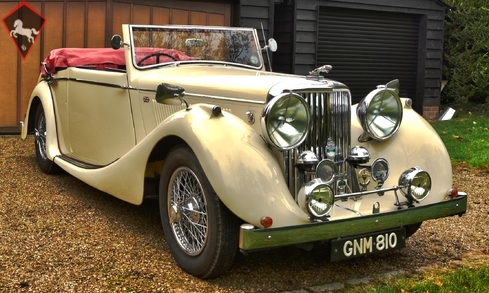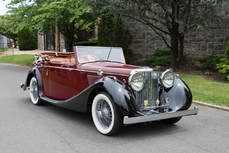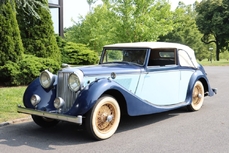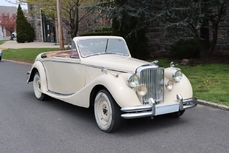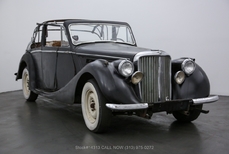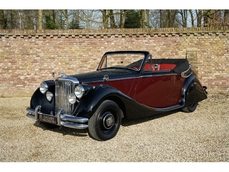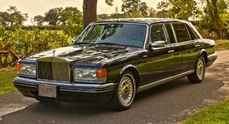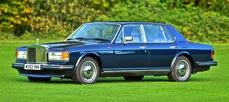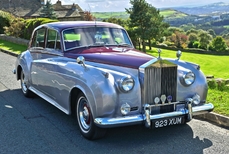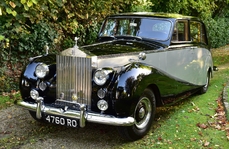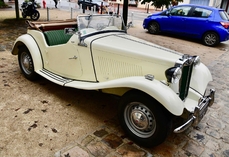Jaguar MkV Drophead Coupé IV 3 1/2 Litre 3 Position Drophead Coupe 1948
General description :
Vintage and Presitge are Proud to offer this 1948 Jaguar MK IV 3 ½ Litre Three Position Drophead Coupe For Sale.
Manufactured in August 1948, chassis number '617141' was retailed via Henlys, London and first registered, as 'GNM 810', on 1st October '48. It is an original right-hand drive, three position drophead coupé, and is one of only 184 RHD models built.
Documentation on file states that the Jaguar was bought circa 1952/53 by Mr Brian Gent of Sherbourne Garage, Idle from Messrs Ebdons (Rootes dealers) of Cheltenham as a one-owner car. Shortly thereafter it was sold to Mr Peter Windle, a chartered surveyor of Appleby Bridge, who used the car for several years before consigning it to storage on his property. It was discovered there in 1975 and subsequently passed into the ownership of Jack Poole.
Restoration commenced around 1990, with the car evolving from there onwards while being used on a regular basis. It featured in Jaguar Quarterly magazine in 1992 with details of the restoration, including pictures, etc. The body was removed from the chassis, which was stripped to the bare frame with only minor repairs required.
All components were crack tested where possible. The engine block was found to be cracked so a replacement was sourced. The flywheel was refaced and a new layshaft found for the gearbox together with bearings, seals, etc. the braking system was overhauled and the front suspension rebuilt with new dampers, kingpins, bushes, etc.
Specialists in Bradford and Ripon re-trimmed the interior, which was completed with new carpets, re-covered door panels and rebuilt instruments. On completion in 1992, 'GNM 810' was considered to be the 'best in the world'.
In November 1997, Jack Poole sold the restored Jaguar to Mr Howard Seymour of Winchester, who used it extensively on events such as the Jaguar Drivers' Club Rally in the USA and JDC tours of Ireland and mainland Europe.
While in the Seymours' ownership, the car featured in Jaguar Monthly magazine (December 1999 edition, copy available). By that time, the Seymours had covered some 15,000 miles in the preceding two years; documentation on file shows that considerable further refurbishment was carried out during 1998 while the car was owned by them.
In August 2000, 'GNM 410' was acquired by Peter Clark of Beeston, Nottingham, during whose ownership the car was repainted by Stallion Motors in Nottingham. In addition, the cylinder head converted to unleaded compatibility; the rear axle rebuilt by Eric Battelle (in 2002); and a Getrag five-speed gearbox from M&C Wilkinson fitted, also in 2002. New wire wheels to original specification were fitted in 2003 together with new hubs all round.
In 2006 the interior woodwork was refinished by Coopers, while in 2007 a new bespoke carpet set was made by Graham Dean. There was an extensive engine rebuild in 2006, and in 2009 the shock absorbers were stripped and rebuilt.
In May 2015 a set of new chrome plated stainless steel wire wheels was fitted, shod with Dunlop Gold Seal tyres. A new mohair hood, with new West of England Cloth interior, was expertly fitted by Kevin Baggs, Poole-based hood specialist, in August 2015. The hood bag in finest Connolly hide matches the red leather seats.
GNM 810 featured in the Jaguar Drivers' Club's Jaguar Driver magazine in a three-page colour article (August 2015 edition); the October 2015 Regtransfers magazine in three-page colour article; and the December 2015 edition of the Jaguar Enthusiasts' Club's magazine in a three-page colour article. Noteworthy features of this unique car include: 1939 Lucas P100DB 'bull's eye' headlamps with figure-of-eight pattern lenses and vertical fluting; Lucas PLG40 spotlamps with tri-bars and correct lenses with vertical fluting; Lucas Long Windtone trumpet horns with optional wide mesh fronts; original Lucas wing mirrors; and an original radio aerial. Of particular interest are four rare badges: National Motorists Association, BRDC, BARC and JDC Members Car Club. The car also comes with an original SS tax disc holder containing a copy of the original 1948 tax disc; a complete set of original tools in the original tray, all fully restored; an original factory sales brochure, workshop manual and service book. The original four cream-painted wire wheels.
The comprehensive history file contains receipts from dozens of leading UK specialists, who have been exclusively entrusted with the supply of all parts and materials used. Two colour articles in the Jaguar Quarterly magazine of July 1992 detail the seven-year painstaking restoration by Jack Poole, while the Jaguar Monthly magazine of December 1999 details the two-year restoration by Howard Seymour , who took the car to USA and won many concours awards there. The file also contains records of the meticulous 13-year mechanical restoration by Peter Clark; a Jaguar Heritage Trust Certificate; and copies of old V5C registration documents.
Built on a generous 120" (3,048mm) wheelbase, the Mark IV retained a separate chassis featuring beam front and live rear axle suspension on semi-elliptic springs, lever-arm dampers, Burman worm-and-nut steering and Girling mechanical brakes. The stylish all-steel coachwork was available in saloon or drophead coupé forms and featured the kind of luxurious and well-appointed interior that would become a Jaguar hallmark. Used by SS Cars since 1934, the engine was Standard's rugged seven-bearing six which in Jaguar specification was fitted with a Weslake overhead-valve cylinder head and coupled to a four-speed manual gearbox; in 3½-litre form capable of propelling the sturdy Mark IV to over 95mph.
Top the Mark IV range was the decidedly voluptuous 3½-Litre Drophead Coupé, a full five seater that boasted an ingenious three-position hood giving occupants the choice of open, closed or coupé de ville motoring. Utilising the same all-steel body construction as its late 1930s SS Jaguar forebear, the newcomer appeared even more svelte thanks to a revised hypoid bevel rear axle that allowed the floor to be lowered by two inches.
http://www.vintagerollsroycecars.com/sales/1248/1948-jaguar-mark-iv-3-litre-three-position-drophead-coup/
1948 Jaguar MkV Drophead Coupé IV 3 1/2 Litre 3 Position Drophead Coupe is listed sold on ClassicDigest in Grays by Vintage Prestige for £110000.
Car Facts
Car type : Car Make : Jaguar Model : MkV Drophead Coupé Model Version : IV 3 1/2 Litre 3 Position Drophead Coupe Engine size : 0.0 Model Year : 1948 Sub type : Coupé Location : Essex
Sold
Seller Information
Sold
People who viewed this Jaguar MkV Drophead Coupé also viewed similar Jaguar listed at ClassicDigest
Other cars listed for sale by this dealer
About Jaguar
Ah, the story of Jaguar, from its early days as the SS Cars Ltd. to its pinnacle with the D-type, and the street-going evolution in the form of the iconic E-type. There's something quintessentially British about this tale, and I'll narrate it as a British journalist might.In the Beginnings:
Our journey into the world of Jaguar begins in the 1930s, when a company known as SS Cars Ltd. emerged. Despite the unfortunate coincidence of their initials with the rising political tensions in Europe, they started producing stylish and performance-oriented cars. The SS 100, introduced in 1936, was a symbol of elegance and speed, setting the stage for what would become Jaguar.
The Birth of Jaguar:
As the shadows of World War II loomed, SS Cars Ltd. wisely decided to disassociate themselves from the SS initials. Thus, in 1945, they officially became Jaguar Cars Ltd., a name that would soon be synonymous with British luxury and performance.
The XK Series:
Jaguar's post-war era brought us the XK 120, a true sensation in 1948. With its sleek design and a powerful 3.4-liter inline-six engine, it became the world's fastest production car. The XK 120 was the blueprint for what lay ahead – Jaguars that blended style with speed in a uniquely British fashion.
The D-type Dominance:
Then came the D-type, a true racing legend. Introduced in 1954, it won Le Mans three times in the 1950s, showcasing Jaguar's engineering prowess. With its innovative monocoque construction and the iconic fin at the back, the D-type was the apex of Jaguar's motorsport success.
The E-type Emergence:
But the true turning point arrived in 1961 with the introduction of the E-type, often described by Enzo Ferrari as "the most beautiful car ever made." Its long bonnet, curvaceous body, and a 3.8-liter engine delivering exhilarating performance made it an instant classic. The E-type was not just a car; it was a work of art on wheels, and it could hit 150 mph on the road.
Street and Racing Success:
The E-type's beauty was matched by its capability on the track. The lightweight E-types were particularly successful in various racing events, cementing Jaguar's reputation as a force to be reckoned with in motorsport.
The Age of Refinement:
As we delve deeper into the Jaguar story, we find that the 1950s and 1960s were an age of refinement and expansion. Alongside the magnificent D-type and the E-type's iconic emergence, Jaguar introduced models that further solidified its reputation for luxury and performance.
The MK2:
In the late 1950s, Jaguar unveiled the MK2, a sports sedan that combined elegance with power. This sleek four-door saloon was a favorite of bank robbers and law enforcement alike, thanks to its exceptional speed and handling. The MK2 was a symbol of Jaguar's ability to blend sophistication with performance and had a successful racing career as well.
The XJ6:
Fast forward to 1968, and Jaguar launched a car that would define luxury saloons for decades to come – the XJ6. It was a masterpiece of engineering and design, featuring a smooth inline-six engine, independent rear suspension, and a spacious, beautifully appointed interior. The XJ6 was a symbol of British elegance and provided a ride so smooth that it seemed to glide over the road. It became the flagship model for Jaguar and set the standard for luxury saloons, showcasing a level of refinement that left competitors in awe.
The Blend of Classic and Modern:
While the MK2 and XJ6 represented the evolution of Jaguar's saloon cars, they maintained the brand's commitment to performance and luxury. These cars didn't just belong on the racetrack; they were equally at home cruising down the grand boulevards or gliding through the English countryside.
The Challenges of Change:
However, as the 1970s arrived, Jaguar, like many British automakers, faced financial challenges and changes in ownership. The British Leyland era brought both opportunities and struggles, as the brand navigated through various mergers and transitions.
Nevertheless, the legacy of the MK2 and XJ6, along with the D-type and E-type, continues to define Jaguar as a manufacturer that combines timeless elegance with a spirit of performance. These classic models, whether driven on winding roads or parked as collectors' treasures, serve as a testament to Jaguar's enduring presence in the world of automotive excellence.
The Jaguar story, from its early days as SS Cars Ltd. to the creation of automotive icons like the E-type, MK2, and XJ6, is a journey that reflects the very essence of British motoring – a blend of luxury, power, and style that continues to captivate enthusiasts and connoisseurs alike.
